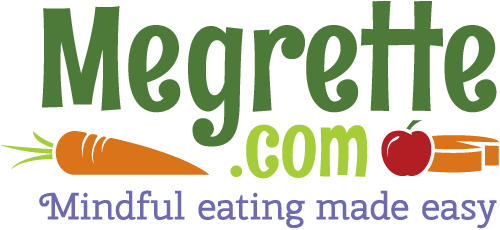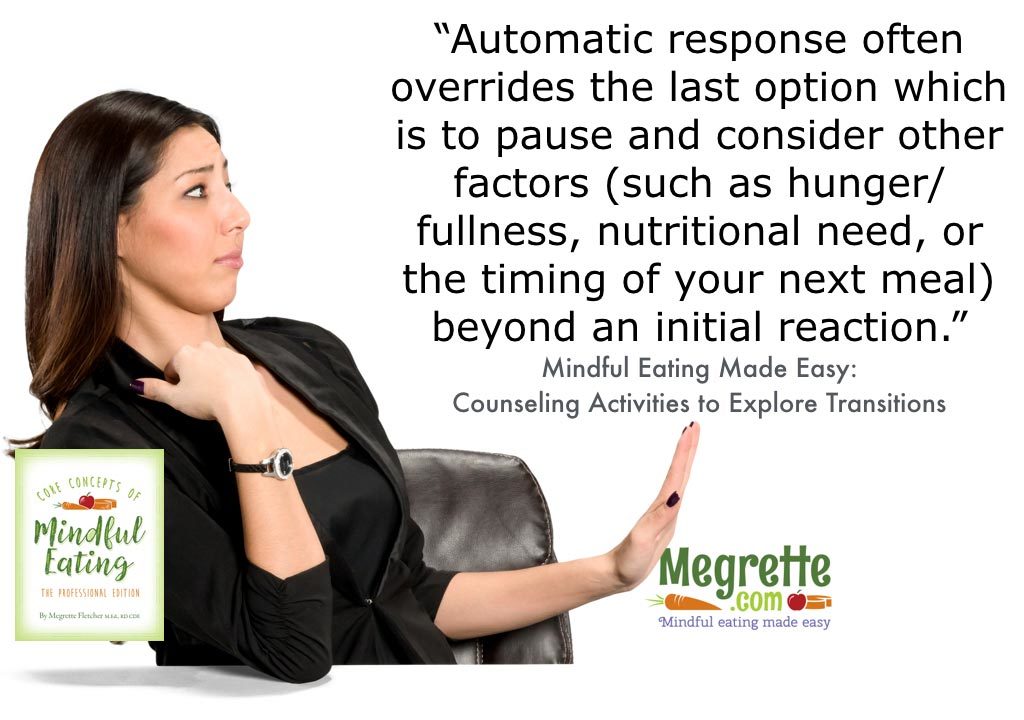You have already learned that transitions, the point where a person moves from one project or event to another are often times of mindless eating. This is because there are many pulls which can distract a person from being present – such as habits, condition-ing, and emotions. In this post we are going to explore why mindful eating helps clients embrace transitions.
Our choices are not based only on knowledge, but on more subtle information which is often so habitual that it goes unnoticed. This information, can be grouped as internal knowledge (sometimes referred to as inner wisdom) and it plays a curious role in the decision making process.
To understand this concept, let us simplify it, into three options, move towards, move away or pause. Let’s look at a food example, if I offered you some kale chips, would you move toward them? If the thought of kale chips makes you say, “Yum,” and you feel your salivary glands activate, you are likely to move toward that choice. However, if the-se dark green crisps aren’t familiar or aren’t on your list of delicious foods, you might say, “No, thank you,” and move away from this choice. The desire to move toward or away from a choice is so automatic that it may be unconscious. This automatic re-sponse often overrides the last option that is to pause and consider other factors (such as hunger/fullness, nutrition need or when the next meal will be offered) beyond an initial reaction.
Neuroscientist Daniel Siegel, MD, offers the analogy of a car to understand how a per-son unconsciously enters into a choice situation. If a person is moving toward some-thing, it is like giving the car some gas. If you’re pressing the gas pedal, you are moving toward a choice. If you don’t wish to move toward something, you use the brake. The gas and brake analogy is helpful for seeing this unconscious force behind the choice. You can modify this analogy for a patient with a simple kinesthetic- learning technique using your hands.
Counseling Activity — GAS, BRAKE, OR BOTH?
Look at a choice, such as eating kale chips. Now place your hands in the stop position. Ask yourself if the stop gesture is how you feel about eating the kale chips. Now try turn-ing your hands over, palms up, in the receiving position. Ask yourself if this accepting position is how you feel about the kale chips. Now turn one hand to the stop
position and the other hand to the accepting position, and ask yourself if this mix of emotions is what you feel about kale chips. How a person responds to a situation is of-ten a mix of emotions. It isn’t as simple as go or stop, gas or brake. Emotions are mixed, and you may find you have the brake and gas on at the same time.
When Clients Get Stuck
Ambivalence is a normal part of the change process and this feeling of “being stuck” is where dietitians can really help clients effectively move through their ambivalent feel-ings.
Here is my recipe to help a client get unstuck.
- Hear the emotion of being stuck with compassionate ears. It might sound like this, “You are feeling stuck. This is frustrating you.” or “You are confused by all the conflicting nutrition information.” or “This pull towards low nutrient foods feels auto-matic, almost instinctual which is scary.”
- Ask the client for their solution. It might sound like this, “What has worked be-fore?” or “What options come to mind to help you?” or “How do you imagine other people might address this problem?”
- Obtain Permission to Explore Other Options. Before launching into a plan to ad-dressing the feeling of being stuck, ask permission first. It might sound like this, “Would it be helpful if we explored other options?” “You would like to focus on getting unstuck.”
If you are struggling with using this recipe in your daily work, consider ways to advance your counseling skills. One option is to digging deeper into Mindful Eating Training or Motivational Interviewing, which offers detailed instructions on resolving ambivalence. If you are curious about other ways to empower and motivate your clients, consider, The Core Concepts of Mindful Eating: Professional Edition. It offers dietitians and health profes-sionals a way to see the big picture of Mindful Eating while using the counseling tech-niques of Motivational Interviewing. If you are looking to deepen your understanding of Mindful Eating The Core Concepts of Mindful Eating LIVE Training starts Tuesday, January 9 from 9-11 AM Eastern Time and runs thru March 13, 2018.



